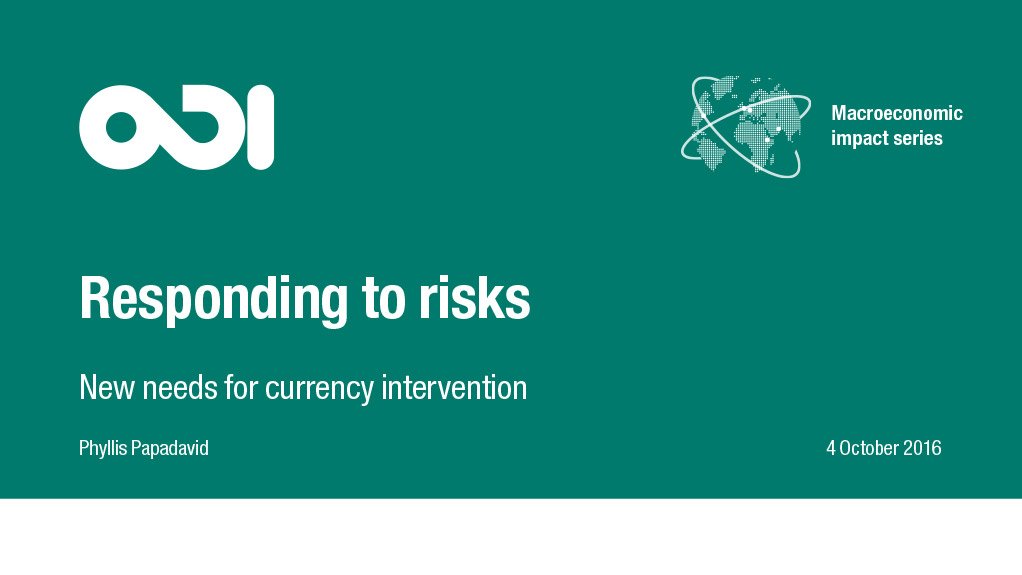- Responding to risks: new needs for currency intervention0.14 MB
Key messages
- The upcoming autumn meetings of the International Monetary Fund and World Bank are likely to focus on the slowdown in global trade and heightened financial risks.
- With global trade growth flat, at around 3% since 2012, currency intervention may be more necessary in some cases to assist adjustment, despite being more politically controversial.
- Financial risks suggest that emerging and developing central banks will need to have more flexible exchange rate policies, to stem currency volatility and safeguard reserves.
Flat-lining growth and heightened risk
The global economy is in a low-growth trap and facing financial risks. There are now questions over the effectiveness of monetary policy, as some central banks reach for increasingly unconventional tools. For emerging and developing countries, foreign exchange reserves are a key buffer to absorb external shocks, and to manage risk. Reserves ensure economies that would otherwise be deemed high risk, are able to reduce those risks and pay lower risk premia, while also allowing for policies to offset adverse growth effects from crises that come with financial openness.
Reserves need to be calibrated to countries’ macroeconomic contexts: current account deficit countries require a higher reserve buffer given their external financing needs. What’s more, investment flows now include riskier types of capital, including high-frequency trading flows, making emerging and developing economies more vulnerable to external financial shocks and where a higher level of foreign reserves would help. This will, in part, necessitate more flexible currency policy to stem volatility and one-directional speculative bets in a country’s exchange rate.
Emerging economies’ foreign exchange reserves are particularly important given these countries’ vulnerability to sudden stops, speculative currency attacks and financial crises. Between Q1 2009 and Q1 2015, emerging and developing country reserves rose from $4.7 trillion to $7.5 trillion, according to the International Monetary Fund COFER data. Yet financial distortions, such as the $13.4 trillion dollars of global debt trading at a negative interest rate could lead to sudden shifts in asset prices that could sharply increase the domestic cost of dollar debt for developing countries, including larger economies, such as India and China’s.
A continued ‘fear of floating’
Financial stability has become a key motivation in FX intervention. A number of central banks have become more active in FX markets since the 2008-2009 financial crisis particularly in Latin America and Asia. And yet, despite more intervention, currency volatility has increased, and financial risk transmission from other asset classes, to exchange rates, has also risen. For example, the hedging of local currency bonds has transmitted volatility from the bond market to currencies.
Currency intervention can help mitigate volatility. However, intervention can sometimes significantly deplete a central bank’s reserves, particularly in emerging market economies where fiscal costs can be higher. And it can come at the cost of reducing reserves that may be needed for future intervention. This can often be substantial: China, a country with $4 trillion in reserves, lost roughly $1 trillion in attempting to defend the renminbi in 2015.
Slower growth, and flat world trade growth, will make the political economy of exchange rate management difficult. Exporters, and oil and commodity producers with a terms-of-trade deterioration, will have a vested interest in a competitive exchange rate. Others, such as importers of capital goods, or consumers, will want to preserve purchasing power. With trade growth decelerating, political opposition to currency flexibility might rise, exacerbating ‘fear of floating’.
Flexible currency intervention
Countries that have built up foreign exchange reserves have done so through introducing an element of flexibility in their currency intervention, or currency regimes. An exchange rate policy based disproportionately on a rules-based approach does not work in reducing volatility. This is evidenced in Mexico, where both the recent regime and the level of the peso that was being targeted, came under speculative attack in February 2016.
An example of effective flexible currency intervention can be found in India. A current account deficit country and an oil importer, and yet over the past decade, India’s foreign exchange reserves have grown from $151 billion in March 2006 to $360 billion in March 2016. Average daily turnover in its FX market has increased from $6 billion per year in 2000 to $60 billion in 2013, according to the Reserve Bank of India (RBI). A distinctive factor in RBI currency policy is the focus on stemming volatility rather than targeting the rupee for export advantage. Indirect intervention through selected banks, has maintained confidentiality and enhanced effectiveness. Crucially, usage of financial instruments (such as FX futures) helped hedge risks, manage domestic liquidity and stem one-directional speculative rupee bets, while economising reserves. The effect of the RBI’s multi-pronged policy has been to enhance the real sector’s access to the market.
A planned item for discussion at the upcoming IMF and World Bank meetings will be how emerging economies can better withstand recent currency volatility. Let’s begin the discussion by considering how to build domestic capacity to institutionalise broader use of financial instruments that would support emerging economies’ central banks countering financial risks. These actions would then bring these economies more in line with some of the strategies employed by central banks in advanced economies.
EMAIL THIS ARTICLE SAVE THIS ARTICLE
To subscribe email subscriptions@creamermedia.co.za or click here
To advertise email advertising@creamermedia.co.za or click here











